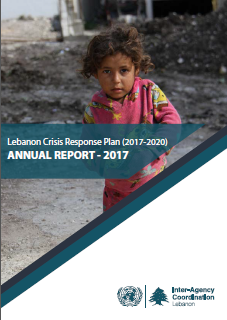Lebanon Crisis Response Plan (2017-2020) ANNUAL REPORT - 2017
 |
rapport Jul 2018 ; 78 pages
Ed. UN-Habitat - Beirut UNICEF - Beirut UNDP - Beirut UNHCR - Beirut
Téléchargeable sous format: PdF
Téléchargeable chez l'éditeur
Page de présentation d'un éditeur
Abstract:
The response to the Syrian crisis is guided by the Lebanon Crisis Response Plan (LCRP), jointly developed by the Government of Lebanon (GoL) and the humanitarian community (United Nations, national and international NGOs and donors) and currently covering a four-year period from 2017 to 2020. It provides an integrated humanitarian and stabilization framework to tackle Lebanon’s challenges holistically, taking into account the vulnerability of all people affected by the crisis.
The LCRP aims to ensure protection and to provide immediate assistance to the most vulnerable populations, primarily the displaced population from Syria, the Lebanese host community and the Palestine refugees in Lebanon. The crisis response plan also aims at strengthening the capacity of national and local service delivery systems to expand access to and quality of basic services. Lastly, the plan strives to reinforce Lebanon’s economic, social and environmental stability.
In 2017, 3.3 million individuals were in need of assistance and 2.8 million were specifically targeted by implementing partners. The LCRP was less than half funded. Out of an overall funding appeal of $2.75bn, $1.24bn was received to support the activities of 65 LCRP partners. Forty percent of this was delivered to vulnerable individuals through a range of cash-based programmes. The funding also includes more than $207 million to strengthen service delivery, policy development, capacity building and institutional stability in the public sector (a 20 percent increase since 2015). Overall, in 2017, 2.3 million individuals effectively benefitted from the Response (82 percent of the target).
Despite large outreach efforts, the response was not able to provide the required level and quality of assistance to the target population. Throughout 2017, partners have mitigated deteriorating of vulnerabilities across ten target sectors of intervention, but have not halted them completely. LCRP impact monitoring shows the following key trends and results:
Protection risks of the vulnerable population remain high, with a lack of legal status among displaced Syrians (74 percent of them did not have a legal residency permit, as of May 2017) and low level of birth registration (17 percent of displaced Syrian families completed the registration process). Children were still engaged in child labour (5 percent of Syrian children aged 5 to 17) as well as affected by violent disciplinary practices (78 percent of them suffered from some form of violence). Early marriage remained high, with 22 percent of displaced Syrian girls aged 15 to 19 married. Overall, trend analysis shows a worsening of protection risk among Syrian households.
Meeting basic humanitarian needs continues to be difficult. The percentage of displaced Syrians living in poverty rose from 71 to 76 percent over the course of one year; shelter conditions deteriorated, with 53 percent of displaced Syrians living in inadequate shelters compared to 46 percent in 2016; 91 percent of them have had a level of food insecurity, slightly improving compared to 2016 (93 percent) and 78 percent had access to improved drinking water sources in 2017, thanks to significant effort made by the humanitarian community.
Access to basic services improves yet remains low. Access to education services improved, with around 430,000 students enrolled in formal public education across the country for the 2017/2018 school year, an eight percent increase compared to the 2016/2017 school year; access to primary health care improved, as 46 percent of displaced Syrian households required primary health care in 2017, and 89 percent of them effectively accessed these services, compared to 84 percent in 2016. Yet, secondary health care services remained difficult to provide; access to improved sanitation facilities has stabilized since 2016, with 86 percent of displaced Syrian households accessing them in 2017.
The employment status of the vulnerable population deteriorates, with only 56 percent of displaced Syrian men aged 15-64 doing some work in 2017. Several research studies indicate a worsening of the employment status compared to 2016. In average, those who worked only did so for 14 days per month. This remains insufficient to cover daily expenses, and as a result 90 percent of families had accumulated debt, at an average of $840 in 2017. The main areas of work, as in previous years, were informal labour in agriculture and construction. 15 percent of households were involved in agricultural livelihood activities, and agriculture was reported as the first source of income in nine percent of households.
Public-Cible:
Mot clef: |
Pays concerné: |
Editeurs/Diffuseurs: |
|
UN-Habitat - Beirut - Liban |
UNICEF
-
United Nations Children's Fund - Beirut - Liban |
UNDP
-
United Nations Development Programme - Beirut - Liban |
UNHCR
-
United Nations High Commissioner for Refugees - Beirut - Liban |
En cas de lien brisé, nous le mentionner à communication@pseau.org